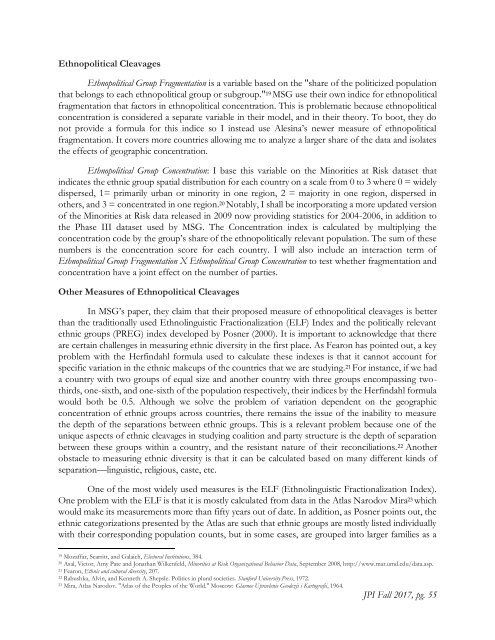Fall 2017 JPI
Create successful ePaper yourself
Turn your PDF publications into a flip-book with our unique Google optimized e-Paper software.
Ethnopolitical Cleavages<br />
Ethnopolitical Group Fragmentation is a variable based on the "share of the politicized population<br />
that belongs to each ethnopolitical group or subgroup." 19 MSG use their own indice for ethnopolitical<br />
fragmentation that factors in ethnopolitical concentration. This is problematic because ethnopolitical<br />
concentration is considered a separate variable in their model, and in their theory. To boot, they do<br />
not provide a formula for this indice so I instead use Alesina’s newer measure of ethnopolitical<br />
fragmentation. It covers more countries allowing me to analyze a larger share of the data and isolates<br />
the effects of geographic concentration.<br />
Ethnopolitical Group Concentration: I base this variable on the Minorities at Risk dataset that<br />
indicates the ethnic group spatial distribution for each country on a scale from 0 to 3 where 0 = widely<br />
dispersed, 1= primarily urban or minority in one region, 2 = majority in one region, dispersed in<br />
others, and 3 = concentrated in one region. 20 Notably, I shall be incorporating a more updated version<br />
of the Minorities at Risk data released in 2009 now providing statistics for 2004-2006, in addition to<br />
the Phase III dataset used by MSG. The Concentration index is calculated by multiplying the<br />
concentration code by the group’s share of the ethnopolitically relevant population. The sum of these<br />
numbers is the concentration score for each country. I will also include an interaction term of<br />
Ethnopolitical Group Fragmentation X Ethnopolitical Group Concentration to test whether fragmentation and<br />
concentration have a joint effect on the number of parties.<br />
Other Measures of Ethnopolitical Cleavages<br />
In MSG’s paper, they claim that their proposed measure of ethnopolitical cleavages is better<br />
than the traditionally used Ethnolinguistic Fractionalization (ELF) Index and the politically relevant<br />
ethnic groups (PREG) index developed by Posner (2000). It is important to acknowledge that there<br />
are certain challenges in measuring ethnic diversity in the first place. As Fearon has pointed out, a key<br />
problem with the Herfindahl formula used to calculate these indexes is that it cannot account for<br />
specific variation in the ethnic makeups of the countries that we are studying. 21 For instance, if we had<br />
a country with two groups of equal size and another country with three groups encompassing twothirds,<br />
one-sixth, and one-sixth of the population respectively, their indices by the Herfindahl formula<br />
would both be 0.5. Although we solve the problem of variation dependent on the geographic<br />
concentration of ethnic groups across countries, there remains the issue of the inability to measure<br />
the depth of the separations between ethnic groups. This is a relevant problem because one of the<br />
unique aspects of ethnic cleavages in studying coalition and party structure is the depth of separation<br />
between these groups within a country, and the resistant nature of their reconciliations. 22 Another<br />
obstacle to measuring ethnic diversity is that it can be calculated based on many different kinds of<br />
separation—linguistic, religious, caste, etc.<br />
One of the most widely used measures is the ELF (Ethnolinguistic Fractionalization Index).<br />
One problem with the ELF is that it is mostly calculated from data in the Atlas Narodov Mira 23 which<br />
would make its measurements more than fifty years out of date. In addition, as Posner points out, the<br />
ethnic categorizations presented by the Atlas are such that ethnic groups are mostly listed individually<br />
with their corresponding population counts, but in some cases, are grouped into larger families as a<br />
19 Mozaffar, Scarritt, and Galaich, Electoral Institutions, 384.<br />
20 Asal, Victor, Amy Pate and Jonathan Wilkenfeld, Minorities at Risk Organizational Behavior Data, September 2008, http://www.mar.umd.edu/data.asp.<br />
21 Fearon, Ethnic and cultural diversity, 207.<br />
22 Rabushka, Alvin, and Kenneth A. Shepsle. Politics in plural societies. Stanford University Press, 1972.<br />
23 Mira, Atlas Narodov. "Atlas of the Peoples of the World." Moscow: Glavnoe Upravlenie Geodezii i Kartografii, 1964.<br />
<strong>JPI</strong> <strong>Fall</strong> <strong>2017</strong>, pg. 55
















